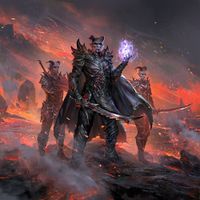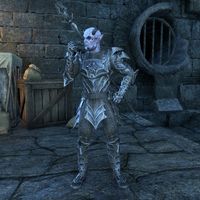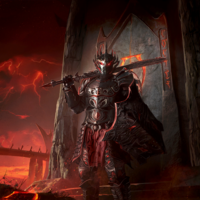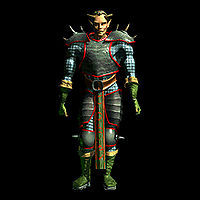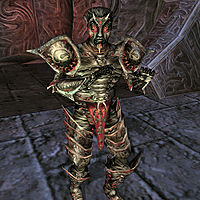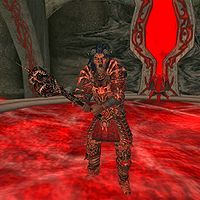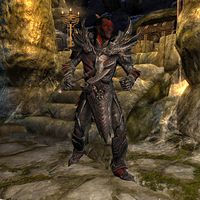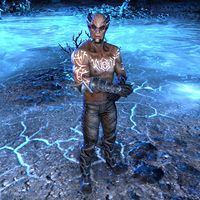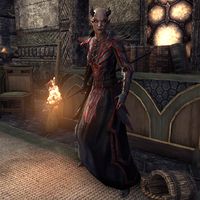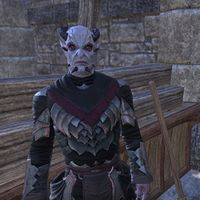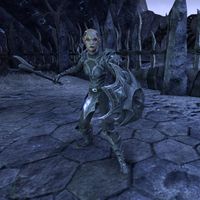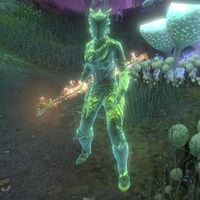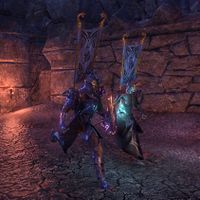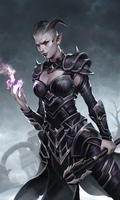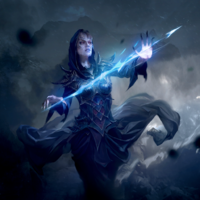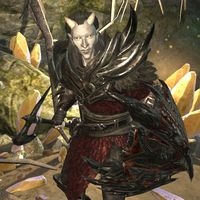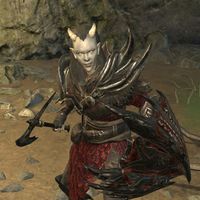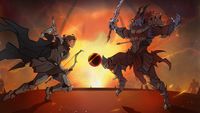Lore:Dremora
Dremora (also known as the Kyn) are a warlike Daedric race primarily associated with the Daedric Prince of Destruction, Mehrunes Dagon.[1] They are often found in the service of other Daedra lords, such as Molag Bal.[2][3] They are commonly encountered throughout the planes of Oblivion.[4] Dremora are known to be highly intelligent beings, and make capable warriors and mages.[5]
The Dremora refer to their race as the Kyn (the People), with the adjectival form being Kynaz (of the Kyn).[1] The name "Dremora" is an arena-term, a nickname used by the Kyn when trafficking with mortals, such as in the context of the Dremora Clan. Different clans make use of such terms in place of their clan's true tribunymic to avoid it being used as a weapon against them.[3]
Dremora consider themselves to be above other Daedra,[6] who are seen as unthinking animals (the primary exception being the Daedric Princes).[1] They also show a mutual distaste for the mortal races of Nirn.[7] Despite this, Dremora are a surprisingly frequent sight in certain parts of Tamriel, roaming Daedric ruins[8] and the lairs of conjurers and Daedra worshipers.[9] They are also summoned to Tamriel through spells and rituals for durations of time that range from brief[10] to indefinite.[11] In this regard, they are often "employed" by Tamrielic organizations such as the Tribunal Temple to guard their shrines,[11][12] and by the Mages Guild to deliver messages to non-guild members.[13] Throughout the years, other professions that Dremora have pursued outside of being warriors for their clans include being torturers,[14] taskmasters,[15][16] pirates,[17][18] butlers,[19] and merchants,[20][21] both in Oblivion and upon Nirn. Some are known to find Daedrats cute.[UOL 1]
The Dremora take pride in their hierarchies. Order is wrested from the chaos of Oblivion through force of will, and the Dremora are nothing if not willful. Rank and order signify glory to the Dremora, as maintaining such things exhibits strength of will.[3] It is their nature to serve those who exhibit a stronger will (such as Daedric Princes), and by serving such entities, the Dremora gain stature and reward. Oblivion is ever-changing, but the oaths held by the Dremora are eternal.[3] Confining oneself to a uniform code and upholding said guidelines is considered an act of supreme will and discipline.[6]
Dremora have keen memories and a tendency to hold grudges.[22] They also have a poor sense of direction.[22] They value their horns, and often refer to things that are shameful or dishonorable as "hornless".[22] The Dremora often serve as go-betweens for mortals who wish to make pacts with Daedric Princes or other powerful entities.[23] Dremora do not view themselves as "good" or "evil". In the case of those who serve a specific purpose for a powerful entity, they exist to serve that purpose. To the Dremora, this is not "good" or "evil", it simply is.[24] The Xivilai find the Dremora's fashion sense and mannerisms to be ostentatious.[6] On the other hand, the Xivkyn outright hold the Dremora in contempt, viewing them as "lesser creatures".[25]
Physical Description[edit]
Dremora are humanoid beings that resemble demon-like knights. In battle, Dremora have been known to wear spiked Daedric armor.[26][27][28] Notable features include horned faces that range from grotesque[29][2] to resembling tattooed Dunmer,[30] deep ashen grey,[31] blue,[32] purple or red[33] complexions, and voices that are deep, watery and guttural.[34] They can also vary widely in height, with some populations being similar to regular humans[35] while other groups stand as tall[36] or even taller than Altmer. [37] During war, some Dremora bear geometric tattoos or war paint that shows their commitment to victory over dishonor.[38]
The Dremora who serve Molag Bal typically have blue or grey skin and blue eyes, but they can vary widely in skin tone and eye color nonetheless.[39] For those who seek to oppose the minions of Molag Bal, these specific features are a dead giveaway.[39]
Dremora are made of a substance that is "of Oblivion" and can, in concert with their clan-attuned nature, leave marks and signs that can only be seen by others of the same attunement (the same clan).[40]
Society[edit]
Dremora society is a class-based clan system that upholds values of oaths,[41] pride, honor and loyalty, both to the clan and to the Daedric lord they serve,[1][7] whom they also venerate as a god.[42][7] Dremora culture appears to focus on training and preparing for battle and war. Dremora warriors fall into one of eight known ranks, each more powerful and privileged than the rank below. These ranks are further distributed into melee, missile or mage classes. Dremora also make for ferocious combatants. This is not just because of their abilities as sorcerers and warriors, but also because, as creatures of Oblivion, they have no need to fear death.[43] Many dremora can reflect spells.[44] They craft and wear their own armor.[6][27][26]
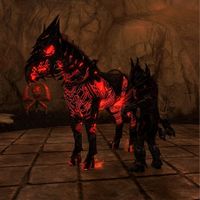
Dremora hierarchy consists of eight major ranks: Varlet,[2] Churl, Caitiff, Kynval, Kynreeve, Kynmarcher, Markynaz, and Valkynaz. The former four represent the military ranks of lesser soldiers. Varlets are the dregs of Dremora society, the lowest of the low and treated the worst out of the bottom four castes.[45] Churls are the untrained disorganized rabble that form the bulk of a clan's fighting force. They obey their superiors, but are cruel to mortals and other Daedra.[1] Caitiffs are shock troops, described as possessing uncalculating zeal. They are unreliable and undisciplined, but eager to perform.[1] Kynvals are the highest ranked of the lesser troops. They are warrior-knights who have distinguished themselves in combat and have displayed the potential to be future leaders of their clans.[1] The Kynval has been described as ambitious.[45] They are the highest of the soldier castes, and may be Caitiffs who have proven themselves in battle.[45]
The other four ranks are officer castes. They are the more important, politically-oriented roles.[1] Kynreeves are described as clan "officers" or "sheriffs", and are associated with fighting units or administrative offices.[1] They administer rewards and punishments to their warrior charges.[45] Kynmarchers are officers of Daedric citadels and outposts, and are the lowest of the ranks that are referred to as "lords".[45] A Kynmarcher's command is associated with a unit and a location or territory for which the officer is responsible.[1] The term Markynaz roughly translates to "grand duke". They form a council of other Dremora of their own standing, known as the "Markyn".[45][1]
The highest known rank is the Valkynaz, which is described as a "warrior duke". They are part of their respective Prince's personal guard or council collectively known as "the Valkyn", and are rarely encountered on Tamriel. A Valkynaz can generally be found beside their chosen Prince, and serve as commanders of important operations.[1] The Valkynaz associated with Molag Bal has the privilege of being granted a personal audience with the Daedric Prince, and can contact him whenever the need arises.[46] There are also many other ranks, such as Baunekyn, Beldakyn, Fearkyn, Ferylkyn, Feydnaz, Gandrakyn, Harstryl, Hauzkyn, Hunterkyn, Kynbek, Kyngald, Kynlurker, Lyrkynaz, Mafrekyn, Morikyn, Narkynaz, Sehtkynaz, Shadowkyn, Soldakyn, and Sovereign whose positions in the overall hierarchy are largely unknown.[47][48] Dremora may rise or fall from a specific rank or move back and forth among clans, but these actions are regulated by complicated oaths and the will of the Prince said Dremora serves.[1][45]
Clans[edit]
There are potentially thousands of Dremora clans. In his early catalogue of explorations of the Oblivion in the Mages Guild library, Divayth Fyr sketched out the heraldry of hundreds of clans.[49]
- Bladebearer Clan — A clan of nomadic Dremora led by Rynkyus.
- Bloodwraith Clan — A faction of Dremora in service to Boethiah.
- Deathbringer Clan — A clan led by Valkynaz Seris, in service to Molag Bal.
- Doomdriven Clan — A clan in service to Malacath.
- Dreamcarver Clan — A clan in service to Vaermina.
- Dremora Clan — A clan led by Imago Storm, in service to Clan Dagon.
- Firescourge Clan
- Foolkillers Clan — A clan in service to Molag Bal.
- Mindcleaver Clan — A clan led by Arox the Mutilator before its fall from power.
- Razorsworn Clan
- Remnants Clan — A clan in service to Hermaeus Mora.
- Ruinblood Clan
- Vanquished Clan
Gallery[edit]
A Dremora tasked with protecting Hermaeus Mora's Rectory Network (ESO)
Dremora gladiators in service to Boethiah (ESO)
Notes[edit]
- In 4E 201, Sanguine assumed the form of a Dremora when he revealed his true identity as a Daedric Prince to the Dragonborn, after the latter visited Misty Grove.[50]
- Though they are primarily followers of Mehrunes Dagon, Dremora have also been associated with many other Daedric Princes. The most prominent of these is Molag Bal, who has entire clans of Dremora in his service.[51]
- The Xivkyn are a Daedric race created by Molag Bal through vesitigal hybridization. They are a "crossbreed" between the Xivilai and Dremora.[25]
See Also[edit]
- For game-specific information, see the Battlespire, Morrowind, Oblivion, Oblivion Mobile, Skyrim, Elder Scrolls Online, Legends, Blades, and Skyrim - The Adventure Game articles.
- For Dremora naming conventions, please see their associated list of names.
Books[edit]
- Darkest Darkness — A description of various Daedra
- I was Summoned by a Mortal by Kynval Zzedenkathik of Clan Deathbringer — A humorous tale of a Dremora's summoning
- Oath of a Dishonored Clan by Lyranth — A Daedric oath
- Pirate King of the Abecean — An ode to the Pirate King
- The Slave Pits of Coldharbour — Instructions for Dremora taskmasters in the service of Molag Bal
- Spirit of the Daedra — A look into the Daedric mindset
- Varieties of Daedra by Aranea Drethan — An analysis of Daedra forms, focusing primarily on the Dremora
- The Will of Drulshasa by Drulshasa — A call for Dremora to sacrifice mortals to Molag Bal
References[edit]
- ^ a b c d e f g h i j k l m Varieties of Daedra — Aranea Drethan
- ^ a b c Kyne's Challenge: A Hunter's Companion: Elsweyr, Dremora
- ^ a b c d Lyranth the Foolkiller Answers Your Questions
- ^ The abundance of Dremora in the Deadlands and Coldharbour in ESO
- ^ The Dremora's ability to speak, combat capabilities and spellcasting abilities in Morrowind, Oblivion, Skyrim and The Elder Scrolls Online
- ^ a b c d Crafting Motif 63: Dremora Style — Lyranth the Foolkiller
- ^ a b c Overheard dialogue from the Imperial City Dremora in ESO
- ^ Appearance of Dremora in Daedric Shrines throughout Morrowind
- ^ Appearance of Dremora in the Worm Cult-occupied Wormroot Depth in ESO
- ^ Temporary Dremora summoning spells available in several games: Summon Dremora in Morrowind, Summon Dremora in Oblivion, and Conjure Dremora Lord in Skyrim
- ^ a b Appearance of Anhaedra in Maar Gan's Shrine, and his role during Pilgrimage to Maar Gan in Morrowind
- ^ Krazzt's appearance in the center of Vivec Palace's Puzzle Canal, and his role during the Pilgrimages of the Seven Graces in Morrowind
- ^ Events of Misdirection in Oblivion
- ^ Molag Bal's dialogue when summoning the Dremora torturers at Dark Anchors in ESO
- ^ The Slave Pits of Coldharbour
- ^ Taskmaster Uldun's name and purpose during Soul Survivors in ESO
- ^ Velehk Sain's appearance in Skyrim and his profession as a pirate
- ^ Pirate King of the Abecean
- ^ The Dremora Butler's appearance and role in Skyrim: Dragonborn
- ^ The Dremora Merchant's appearance and services in Skyrim: Dragonborn
- ^ Krrztrrb's appearance and services in ESO
- ^ a b c I was Summoned by a Mortal — Kynval Zzedenkathik of Clan Deathbringer
- ^ Xykenaz's purpose and dialogue during and after At Any Cost in ESO
- ^ Tachnim's dialogue in ESO
- ^ a b On the Xivkyn — Pelagius Habor, Council Daedrologist-in-Residence
- ^ a b Gathering Force: Arms and Armor of Tamriel; The Pestilence of the Daedra and the Worm Cultist
- ^ a b Crafting Motif 14: Daedric Style — Seif-ij Hidja
- ^ Armored appearance of Dremora in Morrowind, Oblivion, Skyrim and The Elder Scrolls Online
- ^ Tachnim's appearance in ESO
- ^ Appearance of Dremora in Oblivion
- ^ Appearance of Dremora in Skyrim
- ^ Dremora Harstryl's blue complexion in ESO
- ^ Lyranth's appearance in ESO
- ^ Dremora voices in Skyrim and ESO
- ^ Dremora height in Morrowind and ESO
- ^ Dremora height in Oblivion
- ^ Dremora height in Skyrim
- ^ Dremora Kyn Body Tattoo and Dremora Kyn Face Tattoo collectible descriptions in ESO
- ^ a b Kyne's Challenge: A Hunter's Companion; Ogrim and Scamp, Winged Twilight
- ^ Rynkyus' dialogue during The Durance Vile in ESO: The Deadlands
- ^ Molag Bal's dialogue at Dark Anchors in ESO
- ^ Kehothar's dialogue during The Final Assault in ESO
- ^ Spirit of the Daedra
- ^ Dremora abilities in Morrowind
- ^ a b c d e f g The Improved Emperor's Guide to Tamriel/Bangkorai
- ^ Vanus Galerion's dialogue during The Citadel Must Fall in ESO
- ^ Appearance of the Dremora Feydnaz in Oblivion, and the Dremora Kyngald, Narkynaz, et al. in ESO
- ^ Appearance of the Dremora Lyrkynaz, Sehtkynaz, Sovereign in Arms of Chaos
- ^ Mindcleaver Clan Banner antiquty codex entries in ESO: The Deadlands
- ^ Sanguine's appearance in Skyrim
- ^ The Foolkillers and Deathbringer Clans' appearance in ESO
Note: The following references are considered to be unofficial sources. They are included to round off this article and may not be authoritative or conclusive.
| |||||||||||||||||
